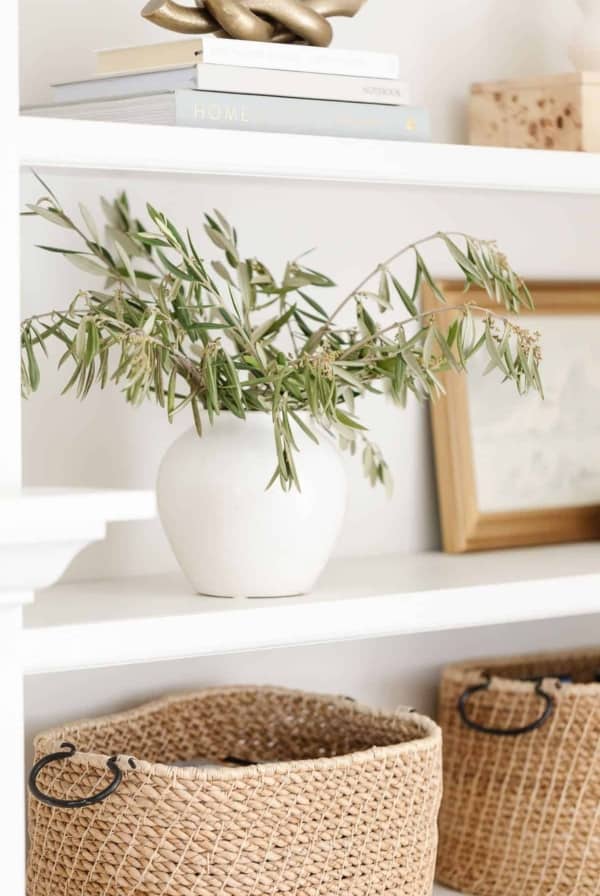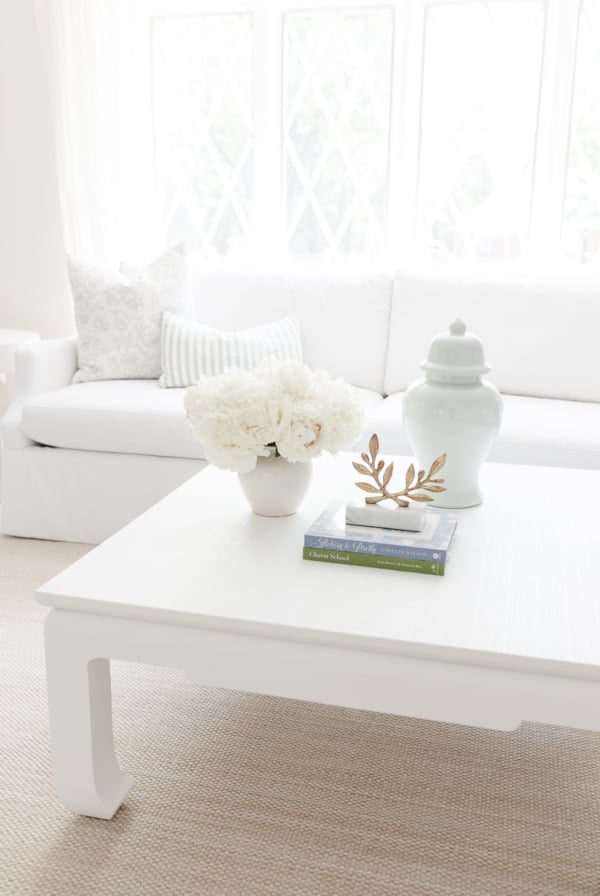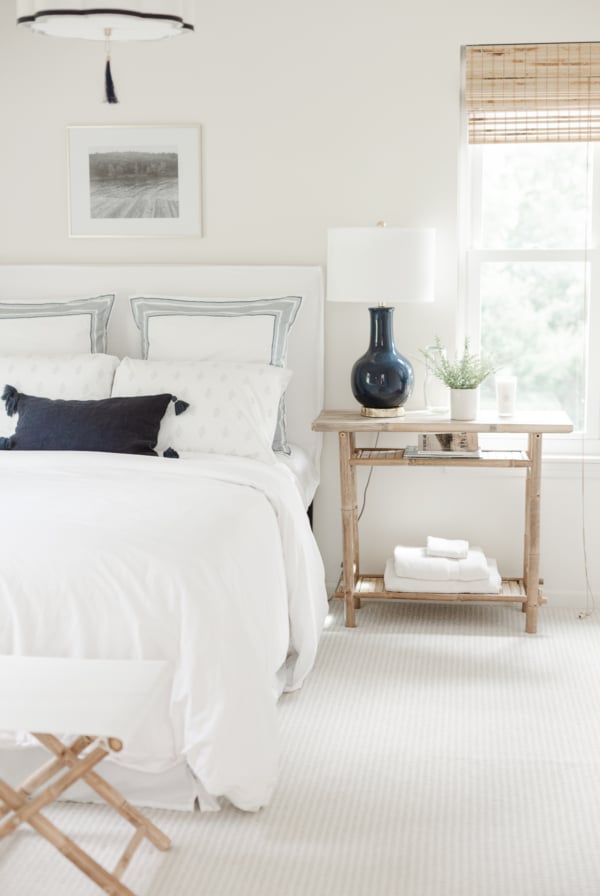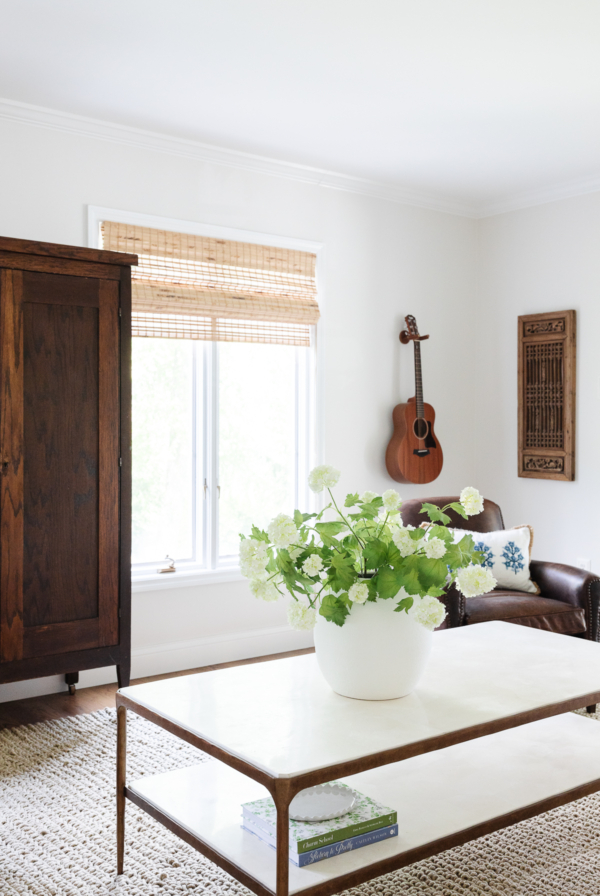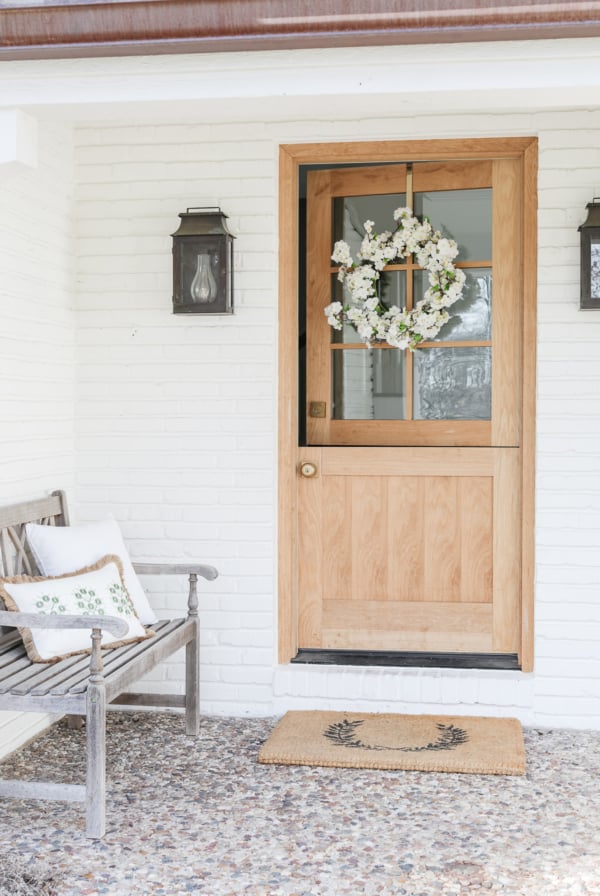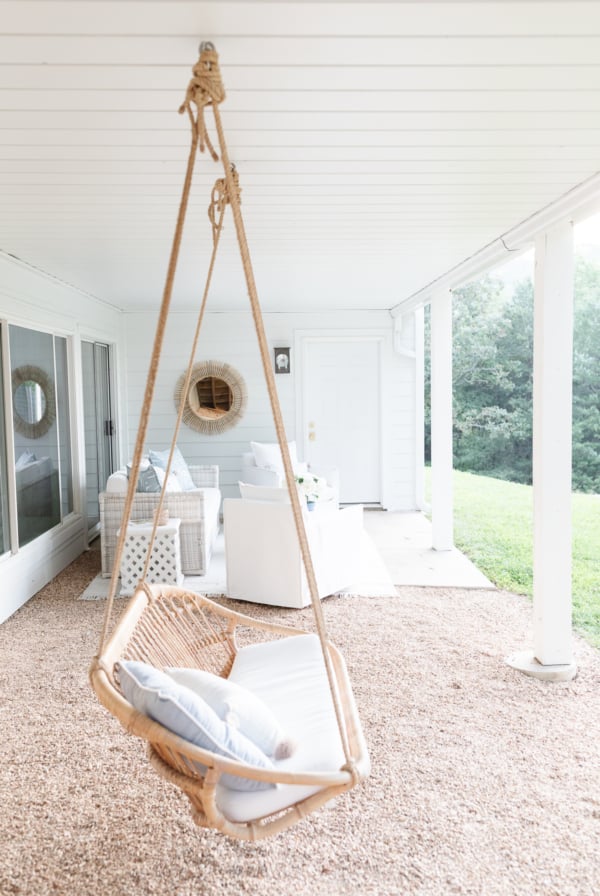The Fiddle Leaf Fig Tree has found its way into hearts and homes all around the world. And it’s easy to see why – the tree’s fun, yet simple shape is visually stunning and works well as living decor in homes.
Although it does require loving and specialized attention, once you learn proper fiddle leaf fig care you can keep your tree flourishing.
Live plants, in general, add calm and natural beauty to a home. Plants interact with the mood of a home to create an atmosphere of peace, productivity, and completeness.
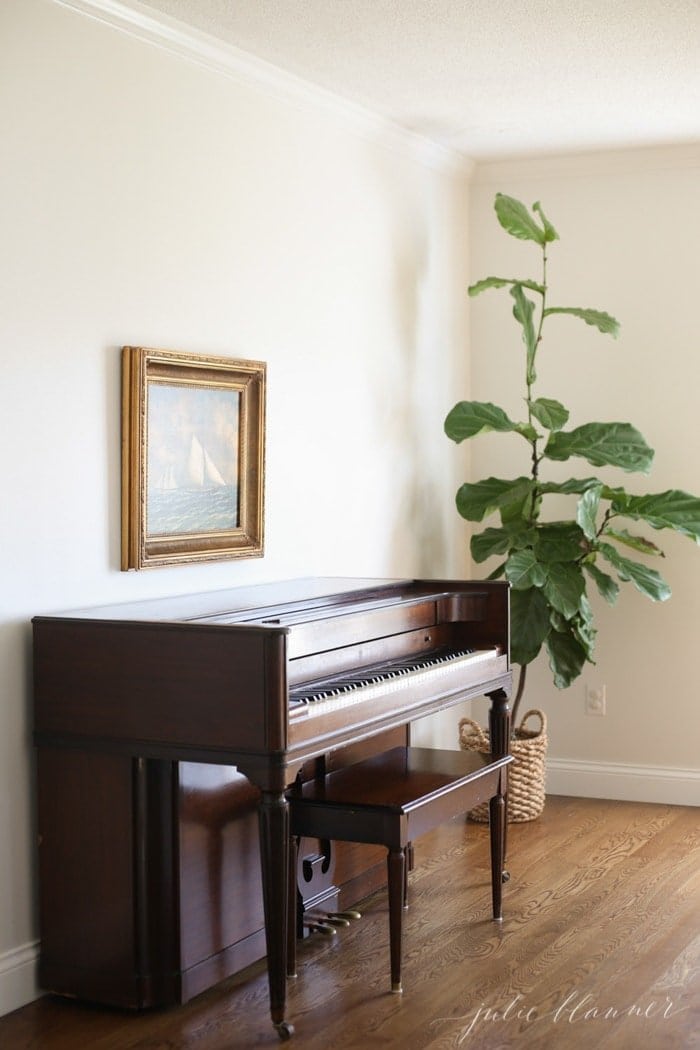
I love chatting plants with you! Read about Five Houseplants You Can’t Kill, Meyer Lemon Trees and ZZ Plants. They are one of my favorite ways to create a warm and Cozy Home!
The fiddle leaf fig tree is a stunning choice in home decor. Robust leaves atop a thin trunk let the tree stand out, while its organic nature allows it to quietly blend into the background.
It has the reputation of being finicky, but really it is just a creature – or plant – of habit. It requires consistent care, it doesn’t respond well to change, and its needs have to be met – not too different than most living things, really.
If you can commit to those requirements, the fiddle fig tree could be a great choice for you.
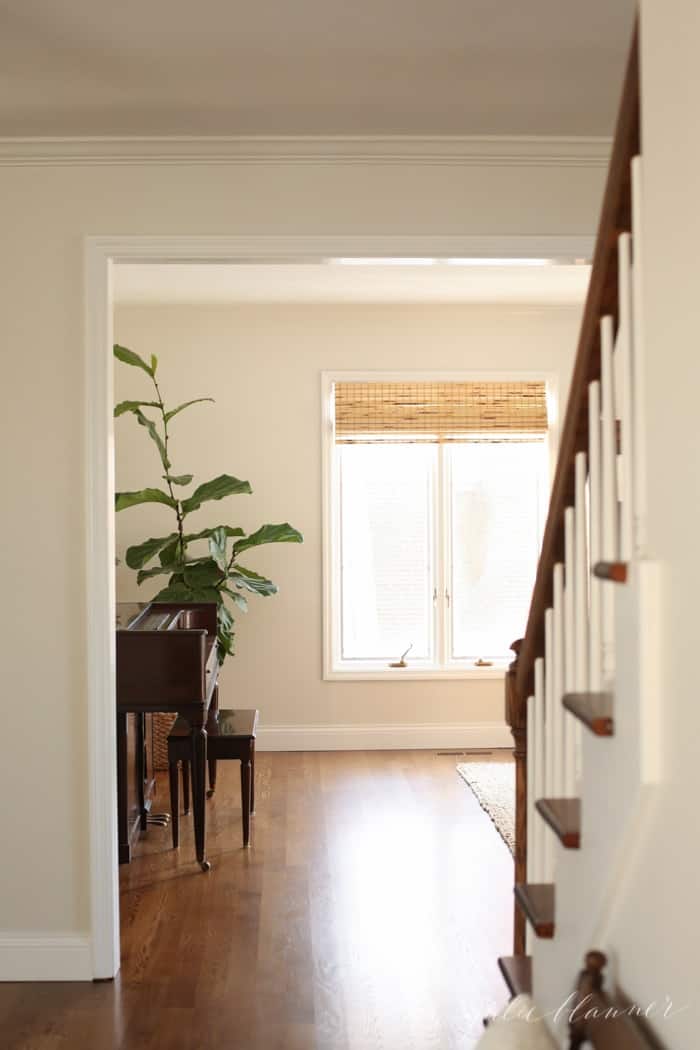
What Is a Fiddle Leaf Fig Tree?
The Fiddle Leaf Fig Tree, Ficus lyrata, is appropriately named due to its leaves that are similar in shape to a fiddle or violin. In its native habitat – the lowland rainforests of Western and Central Africa – it actually produces figs, hence the rest of its name. It does not, however, produce figs as a transplant inside homes.
Its dark, vivid green leaves are broad, heavily veined, and turn upward. They are thick and waxy in appearance, giving it a tropical vibe. In its natural environment the fiddle leaf fig tree can grow up to 50 feet, but grows to a maximum height of just 10 feet in a home.
The big leaves, vibrant color, and slim trunk make it a beautiful statement piece in rooms. The plant can be trimmed to look like a small tree with one bare trunk that supports leaves up high. It can also be a plump bush with multiple trunks and a lot of leaves lower on the trunks, whichever suits your style.
Fiddle figs, when properly cared for, will bring any space to life in your home with a vibrant, yet peaceful look.
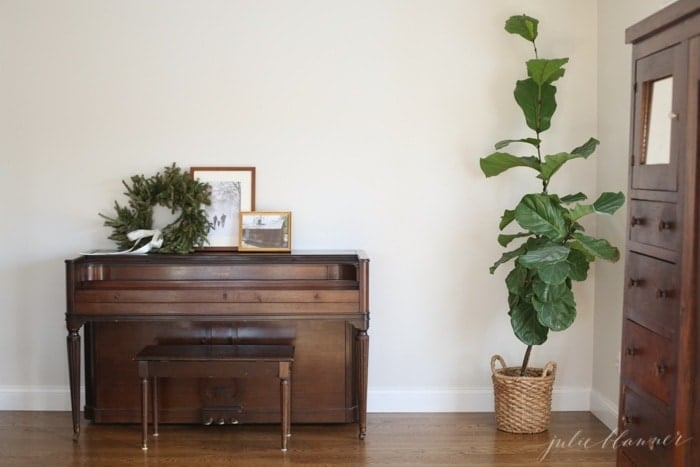
Fiddle Leaf Fig Care
You definitely need to pay attention to your fiddle leaf fig tree if you want to successfully keep it alive and beautiful in your home. It is a hearty plant, though, and should react positively to the proper care.
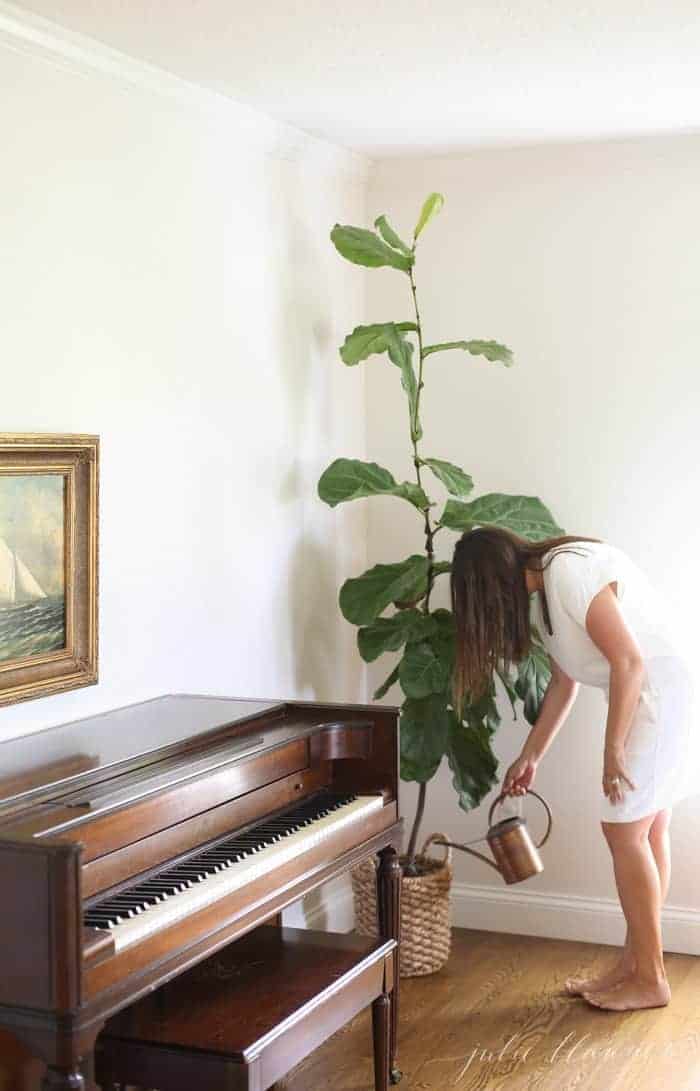
Placement and Light
Before you even bring a fiddle leaf fig home to your house you should make sure you have a place to put it. Remember, its native habitat is a rainforest, so you need to partially be able to recreate that.
Your first step is to locate a light source – the window. Southern and western facing windows are the prime source for the right amount of sunshine. Fiddle figs prefer filtered light, so consider having a sheer curtain in front of your window. The window should be away from vents and drafts because it doesn’t like persistent air blowing on it.
Another way to mimic the natural environment is to have the right amount of humidity; 30-65% is just right. Many houses fall into that range, but you can always get a humidifier to help. If that’s not a possibility, add more moisture by lightly spraying clean water onto the leaves once a week.
Once the environment is suitable for your plant, you’re ready to bring it home. When it is in the perfect place, rotate your plant every time you water it to make sure that every side of your plant is getting light from the sun.
This will help it to grow straight, instead of one side leaning toward the light. Rotating will also keep it from getting a sunburn on the side that is facing the window.
Watering Your Fiddle Fig
It goes without saying that water can either make or break (a.k.a. kill) your plant. Too much water or not enough water are both harmful to your plant. They really need just the right amount of water to stay healthy.
To recreate its African homeland where it gets a lot of rain and then a dry spell, fiddle leaf fig trees should follow the same pattern of receiving water.
Water it thoroughly, letting the water run through the drainage holes at the bottom of the pot. The roots shouldn’t sit in a pool of water, so remove the excess water by elevating your fig tree to allow the water to empty into a drip tray.
And then you need to allow the soil to dry considerably before watering again. Ideally, the top 2 inches of soil should be dry before you water it again. Just stick your finger in the soil to check if it is dry or still moist.
Generally, you’ll need to water every week to 10 days. Remember to rotate your plant when you water it.
Fertilizing
As with all plants, fertilization contributes to the health and beauty of your fiddle leaf fig. Fertilizer will aid in new leaf growth and height.
During the spring and summer months, fertilize your plant with a liquid fertilizer every other time you water, diluting it according to fertilizer directions. The ideal nitrogen-phosphorous-potassium ratio is 3-1-2, so use a fertilizer with that ratio.
In the fall, reduce the fertilizing frequency to once a month. Fiddle leaf figs are dormant during the winter months and don’t require fertilizer then.
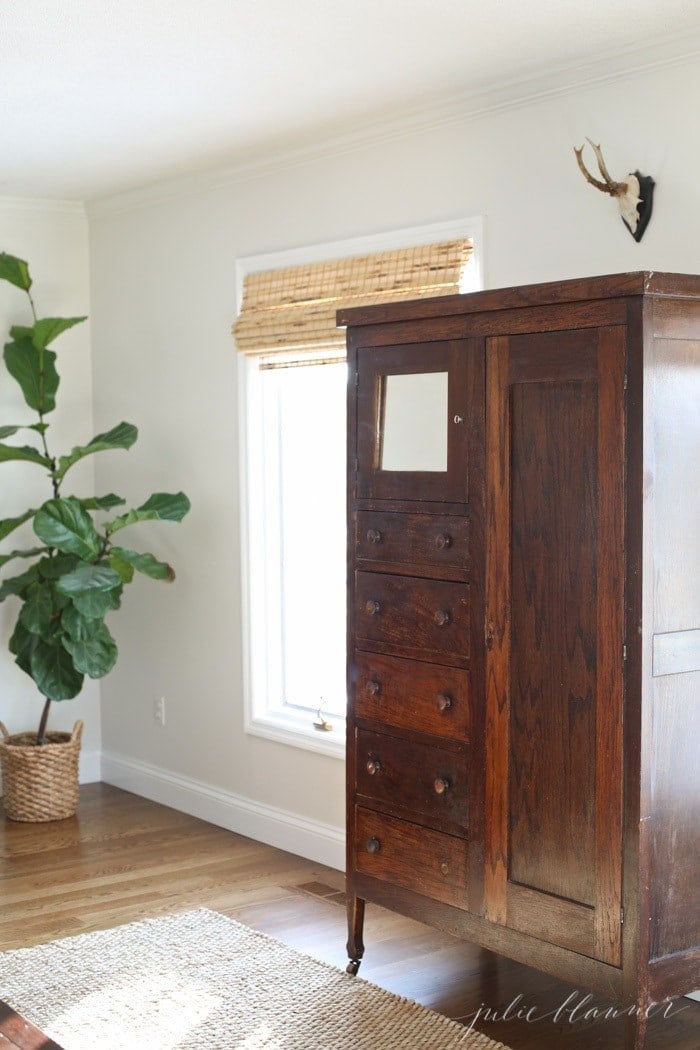
Soil and Repotting
When you initially bring your fiddle fig tree home, leave it in its original pot until it can adjust to its new environment. It can’t have too many changes at once, so a new environment and new pot might be too much for it to handle.
If you don’t like its original pot, simply put the original pot inside a decorative pot to make it look nice while you’re waiting to repot.
As the tree grows it can be transplanted into a larger pot every year or two. Choose a larger pot that is about 2 inches bigger in diameter The spring and summer are great seasons to repot because the tree is strong and can adjust more quickly to its new home.
Any quality soil designed for house plants will work for fiddle leaf fig trees. A good soil will help improve drainage to prevent root rot, and provide necessary nutrients for growth and health.
Pruning
As leaves die or become brown, they will need to be removed to prevent infection. Plus, you don’t want damaged leaves taking nutrients away from healthy leaves.
Using sharp, clean pruning shears, snip brown or yellowing leaves at the base of the leaf. Only snip off as many as 5 leaves at a time to prevent shock to the plant.
If you want a fiddle fig tree that has a long trunk with leaves just at the top, follow the same pruning method by trimming off a few leaves at a time to clear the trunk.
Fiddle leaf figs have a tendency to become lopsided, due to growing toward the sun or just from unbalanced stem growth. Using sharp, clean pruning shears, trim and shape your fig tree for aesthetics and to allow air to flow between the leaves.
Your fiddle leaf fig tree may grow so well that it gets too tall for your room. You can cut off the top of your plant a few inches below ceiling height. This will keep your tree strong and the right height for your room.
Fiddle Leaf Fig Root and Leaf Maintenance
Keep the roots of your fiddle fig tree healthy by following proper watering schedules. Healthy roots are white and hard, while unhealthy roots will become soft and brown.
If you notice unhealthy roots, you need to gently remove old soil and damaged roots, and then repot your plant with fresh, clean soil. Use a root rot treatment to nurture healthy roots. Proceed with care by allowing the soil to drain and waiting for the top two inches to dry before watering again.
When you see roots growing out of the drainage holes in your pot, it is time to advance to the next size of pot. Gently remove plant, loosen old soil from root ball, put a layer of fresh soil in a 2 inch larger pot, place root ball inside, and finally, top with more soil up to an inch below the top of the pot.
Leaves also require care. When you notice that the tree’s brilliant green color isn’t so stunning anymore, it’s probably covered in dust. With a soft cloth and a spray bottle filled with clean water, spray and gently wipe the leaves to remove dust build up.
As you dust the leaves, be on the lookout for unhealthy leaves. Remove them as needed. Also check for insects that could harm your tree, like gnats or mites. If you see small spots, groups of gnats, or small webs, purchase a treatment that will rid your tree of them.
Fiddle Leaf Fig Tree Troubleshooting
It is normal for a fiddle leaf fig tree to drop a few leaves when it is adjusting to your home. So don’t worry if that happens in the beginning. However, if it continues for a prolonged time, examine the leaves and look for discoloration.
Leaves that have yellow and/or brown spots have been overwatered. Make sure the top 2 inches of soil have dried before the next watering. Also, drain the excess water so it doesn’t collect around the roots.
If the leaves are brown and curling around the edges, a water shortage is to blame. A fiddle fig tree requires water at least every 10 days.
If you notice your tree’s leaves are facing down or drooping, it is probably a watering issue and it needs more water, or it just needs the water to be done on a schedule similar to flooding then drought.
Faux Fiddle Leaf Fig Tree
The beauty of a living and healthy fig tree is unsurpassed. But every plant owner knows how green their thumb actually is, and whether or not they want to become parents of a fiddle fig plant.
If you don’t have the patience or desire to provide proper fiddle leaf fig care, but you love the look of the broad, green leaves, then consider a faux plant.
Faux fiddle leaf fig trees are sold at many retailers online and in stores. You can choose the exact size and shape you want – and it will stay that way without any pruning!
Put it in a decorative pot that suits the style of your house for the finishing touch and a polished look. If you want to be really sneaky, you can fill the top inch of the pot with real soil to make it look even more realistic.
Keep your faux fiddle leaf fig tree looking beautiful by dusting it regularly. And unlike live trees, you can place a faux tree anywhere in the room without having to worry about sunlight. Without the work of a live plant, you can sit back and enjoy the design of your fiddle leaf fig tree.
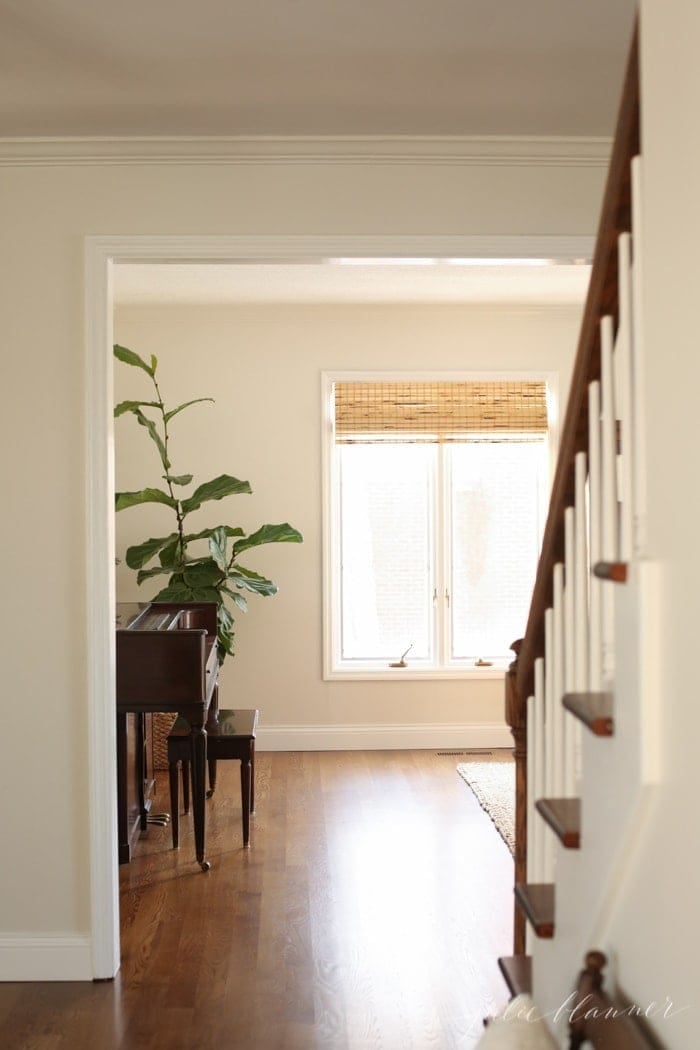
Frequently Asked Questions
They need 6-8 hours of filtered sun a day, just like in their natural full-sun habitat. Keep the light filtered with a sheer panel to avoid sunburn on the leaves. Rotate your plant about a quarter turn every week to 10 days, or when you water it.
Its native environment is in rainforest lowlands in Africa, where it grows very well. It has become a popular choice as an indoor plant because of its beauty, but it does require diligent care as an indoor plant.
